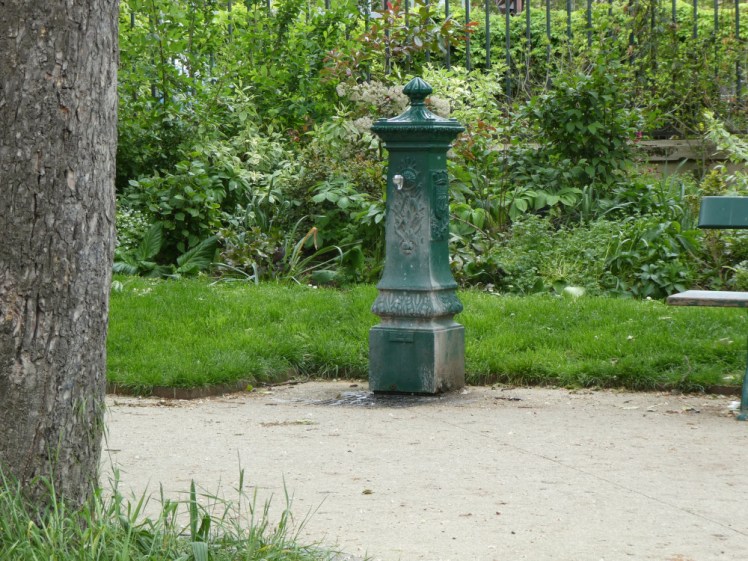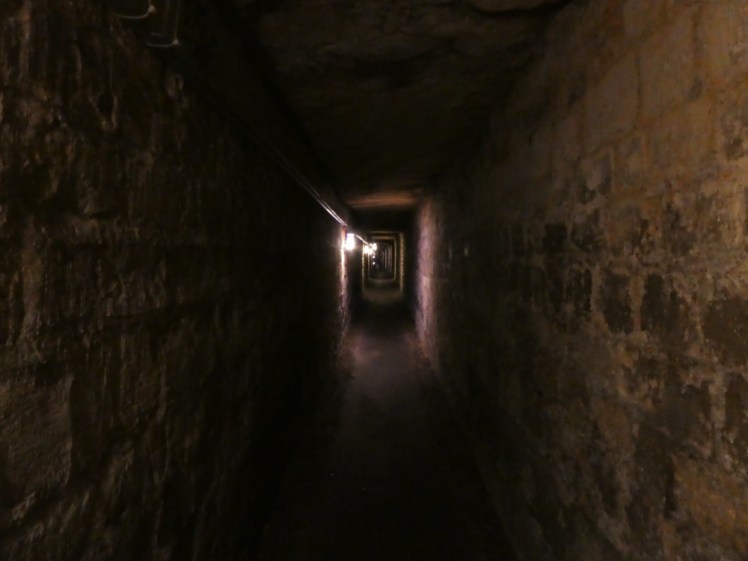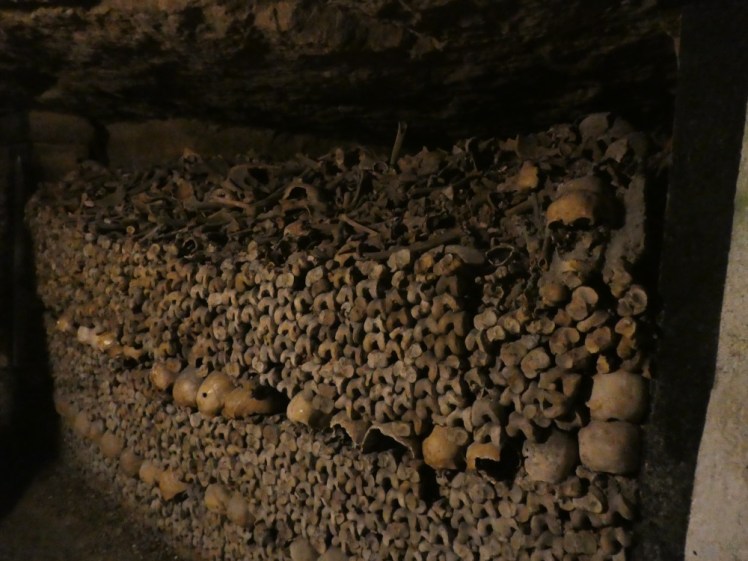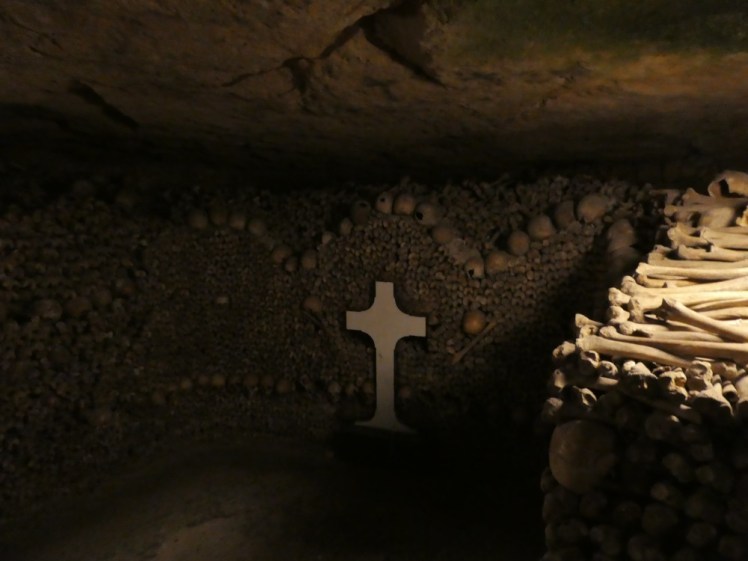One thing I’ve meant to do in Paris for years is the Catacombs. I knew very little about them; only that they were underground and went on forever. When I went to Paris last month, I added them to my tentative to-do list, having discovered that tickets only go on sale four days in advance and sell out quickly. It was likely I’d miss out, not least because four days before the weekend, I’d be at work and probably not thinking about booking Catacombs tickets. But by some miracle, I did think of it in that brief window while they were on sale and there were plenty of Saturday afternoon tickets available, which was when I wanted.
It wasn’t until I was actually in Paris that I discovered the other thing I thought I knew about the Catacombs, that they were around and under Notre Dame, was completely wrong. They are indeed under RER line B which you can get at Notre Dame but in fact, they’re right on the edge of the city, at Denfert-Rochereau, which I was vaguely acquainted with, having passed through it on my way into the city from Orly airport.

Saturday was a hot day. I went to Sainte-Chapelle in the morning, took a boat trip around lunchtime and moped around wondering why it was I wasn’t loving Paris. I’ve never loved Paris and concluded, on two solo trips where I began to take to the city, that the difference was in doing what I wanted, when I wanted, on my own terms. Which was exactly what I was doing. So why was I not taking to Paris again? And then it dawned on me. Those two solo trips were in January and November. I like Paris in the winter!
The reason I’d telling you this is that I was too hot, in an uncomfortable way. I spent two hours sailing up and down the river, wishing desperately that I could put my hot feet in the water and utterly unable to do so. When I arrived in Denfert-Rochereau, it was far too early to queue for the Catacombs so I sat in a bit of park around the back of the building, where I spied a public drinking fountain. Oh joy, oh glory! I pressed the button to switch it on, pulled up my trouser legs and let the water run over my feet. Why was I wearing trousers? Because I was about to go deep underground. They zip off into shorts and I’d spent most of the morning in shorts but in preparation for going into the Catacombs, I’d reattached the legs. That was the most amazing cold water I’ve ever felt.

Anyway, I joined the queue for my timeslot and eventually, we were sent in. Walk through the metal detector while the security guard gives your bag the most half-hearted “is there a stick of dynamite and an alarm clock sitting on top?” check. Show your ticket three times and get an audioguide and then it was time to descend.
The Catacombs are 20m below the streets of Paris. Denfert-Rochereau is pretty firmly Paris now but in the days when the Catacombs were active limestone mines, this was the edge of the city, the suburbs at most. They dug a lot of limestone out. So much, in fact, that Paris began to fall into the holes left behind. Somewhere around the mid/late 1770s – about a decade before Paris had other things to think about – they began a project of stabilising the tunnels to stop the entire city collapsing. Then they had another bright idea. A large city like Paris generates a certain stream of dead people. A river, in fact. The cemeteries were full and there were so many bodies, and so many of them presumably not buried as deeply as would have been liked, that disease was starting to spread. Food and milk in houses nearby went bad within hours. People became ill and died and that just meant more bodies for the overflowing cemeteries to deal with. So someone had the bright idea to dig up all the bodies and dump them in the old limestone tunnels.

Later, they tidied them up. Initially, they were literally dumped in pits. It was done in a reasonably ceremonious way, in that the bones were conveyed in proper hearses, after dark so as to not distress the locals, but dumped nonetheless. Later on, the bodies from particular cemeteries were collected together and then they were built up into piles, using thigh bones and skulls to make strong walls behind which the smaller ones were piled up. Just plain piles aren’t very space-efficient and they would have collapsed, which was good for neither the dead nor the living.

What did the living have to do with it? Well, pretty much right from the start, the Catacombs were open to the public. They made a kind of cavalcade of death under the streets of Paris. Set into each cemetery’s bay is a square plaque, carved with quotes and poems about life and death. There’s a warning over the gateway, declaring “This is the empire of death”.
The first bit was just walking through old limestone galleries. The audioguide explained the various methods they used for holding the roof up, the different kinds of pillars, the history of the mines etc. But then you reach the ossuary and it all takes a turn. These are real dead bodies, six million of them, and as such, this is a burial site and it’s illegal to disturb the bones. Don’t touch them and if you’re carrying a backpack, put it on your front so you don’t accidentally knock anything.

By this point, I’d realised this was an ossuary, a bone collection. I knew that going in. But it’s not until you’re walking among them you really realise – these are dead people. These are real dead Parisians. Every one of those skulls, a few hundred years ago, was an actual person living in this city. These aren’t props, or plastic or resin. These aren’t Halloween decorations. These are dead people.
Fine. Fine. I knew that. They’re dead people whose remains are being dealt with as tidily and respectfully as possible, in a city where the number of dead got out of control. It’s a bit dark and I’m not sure about the propriety of making this a tourist destination but… fine. The decorative poems and quotes… fine. What I was less sure about was when I noticed one bone wall decorated with a heart made of skulls. The skulls and big bones making walls is practical rather than pretty but to use actual human remains as decoration, that felt like it was on the other side of my personal line.

The big “barrel”, I forget its actual name, a kind of barrel-shaped formation of bones, that seemed unnecessary too, although I was distracted here by the audioguide telling me about a midnight concert held illegally here. I can’t remember when but it’s got all the hallmarks of the ages of hedonism and revelry. 1897. There it is. Yes, they held a midnight concert here in 1897, featuring a miniature orchestra who played all the dark hits, like the Funeral March and Saint-Saens’ Danse Macabre, which you and I probably know best as the theme music from Jonathan Creek. In a way, eeewwww. On the other hand, I can appreciate the humour of choosing the creepiest playlist for your illegal midnight ossuary party.

But possibly the worst bit came at the end. It’s somewhere around 200 spiral stone stairs up and down and you emerge half a kilometre into town (with, frankly, not enough signs pointing you back to the beginning and the station!). At the top of the steps sit two bored security men who want to check your bag again. In case you’ve stolen any bones. Who steals bones?? Apart from the fact that you’re assured down there that it’s illegal, and how am I going to get them home in my hand luggage anyway, who wants to disturb graves and steal bones?
I’ll leave you with the first of a Twitter thread from Jay Hulme, who is a poet and church enthusiast. He’s a churchwarden at one of England’s very oldest churches and among other duties, he finds bones in the churchyard which have worked their way to the surface. I thought about this thread a lot as I walked through the ossuary.
One thought on “There are 6 million dead bodies under Paris”